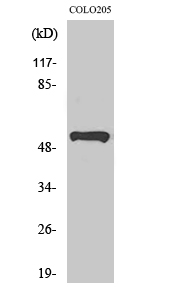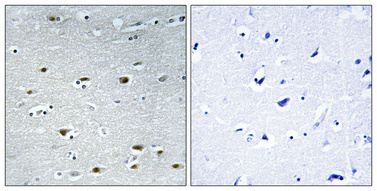PRP19 Polyclonal Antibody
- SPECIFICATION
- CITATIONS
- PROTOCOLS
- BACKGROUND

Application
| WB, IHC-P |
|---|---|
| Primary Accession | Q9UMS4 |
| Reactivity | Human, Mouse, Rat |
| Host | Rabbit |
| Clonality | Polyclonal |
| Calculated MW | 55181 Da |
| Gene ID | 27339 |
|---|---|
| Other Names | PRPF19; NMP200; PRP19; SNEV; Pre-mRNA-processing factor 19; Nuclear matrix protein 200; PRP19/PSO4 homolog; hPso4; Senescence evasion factor |
| Dilution | WB~~Western Blot: 1/500 - 1/2000. Immunohistochemistry: 1/100 - 1/300. ELISA: 1/40000. Not yet tested in other applications. IHC-P~~N/A |
| Format | Liquid in PBS containing 50% glycerol, 0.5% BSA and 0.09% (W/V) sodium azide. |
| Storage Conditions | -20℃ |
| Name | PRPF19 (HGNC:17896) |
|---|---|
| Function | Ubiquitin-protein ligase which is a core component of several complexes mainly involved pre-mRNA splicing and DNA repair. Required for pre-mRNA splicing as component of the spliceosome (PubMed:28076346, PubMed:28502770, PubMed:29301961, PubMed:29360106, PubMed:30705154). Core component of the PRP19C/Prp19 complex/NTC/Nineteen complex which is part of the spliceosome and participates in its assembly, its remodeling and is required for its activity. During assembly of the spliceosome, mediates 'Lys-63'-linked polyubiquitination of the U4 spliceosomal protein PRPF3. Ubiquitination of PRPF3 allows its recognition by the U5 component PRPF8 and stabilizes the U4/U5/U6 tri- snRNP spliceosomal complex (PubMed:20595234). Recruited to RNA polymerase II C-terminal domain (CTD) and the pre-mRNA, it may also couple the transcriptional and spliceosomal machineries (PubMed:21536736). The XAB2 complex, which contains PRPF19, is also involved in pre-mRNA splicing, transcription and transcription-coupled repair (PubMed:17981804). Beside its role in pre-mRNA splicing PRPF19, as part of the PRP19-CDC5L complex, plays a role in the DNA damage response/DDR. It is recruited to the sites of DNA damage by the RPA complex where PRPF19 directly ubiquitinates RPA1 and RPA2. 'Lys-63'- linked polyubiquitination of the RPA complex allows the recruitment of the ATR-ATRIP complex and the activation of ATR, a master regulator of the DNA damage response (PubMed:24332808). May also play a role in DNA double-strand break (DSB) repair by recruiting the repair factor SETMAR to altered DNA (PubMed:18263876). As part of the PSO4 complex may also be involved in the DNA interstrand cross-links/ICLs repair process (PubMed:16223718). In addition, may also mediate 'Lys-48'-linked polyubiquitination of substrates and play a role in proteasomal degradation (PubMed:11435423). May play a role in the biogenesis of lipid droplets (By similarity). May play a role in neural differentiation possibly through its function as part of the spliceosome (By similarity). |
| Cellular Location | Nucleus. Nucleus, nucleoplasm. Cytoplasm, cytoskeleton, spindle. Cytoplasm. Lipid droplet {ECO:0000250|UniProtKB:Q99KP6}. Note=Nucleoplasmic in interphase cells Irregularly distributed in anaphase cells. In prophase cells, uniformly distributed, but not associated with condensing chromosomes. Found in extrachromosomal regions in metaphase cells. Mainly localized to the mitotic spindle apparatus when chromosomes segregate during anaphase When nuclei reform during late telophase, uniformly distributed in daughter cells and displays no preferred association with decondensing chromatin. Recruited on damaged DNA at sites of double-strand break |
| Tissue Location | Ubiquitous. Weakly expressed in senescent cells of different tissue origins. Highly expressed in tumor cell lines |

Thousands of laboratories across the world have published research that depended on the performance of antibodies from Abcepta to advance their research. Check out links to articles that cite our products in major peer-reviewed journals, organized by research category.
info@abcepta.com, and receive a free "I Love Antibodies" mug.
Provided below are standard protocols that you may find useful for product applications.
Background
Ubiquitin-protein ligase which is a core component of several complexes mainly involved pre-mRNA splicing and DNA repair. Core component of the PRP19C/Prp19 complex/NTC/Nineteen complex which is part of the spliceosome and participates in its assembly, its remodeling and is required for its activity. During assembly of the spliceosome, mediates 'Lys-63'-linked polyubiquitination of the U4 spliceosomal protein PRPF3. Ubiquitination of PRPF3 allows its recognition by the U5 component PRPF8 and stabilizes the U4/U5/U6 tri-snRNP spliceosomal complex (PubMed:20595234). Recruited to RNA polymerase II C-terminal domain (CTD) and the pre-mRNA, it may also couple the transcriptional and spliceosomal machineries (PubMed:21536736). The XAB2 complex, which contains PRPF19, is also involved in pre- mRNA splicing, transcription and transcription-coupled repair (PubMed:17981804). Beside its role in pre-mRNA splicing PRPF19, as part of the PRP19-CDC5L complex, plays a role in the DNA damage response/DDR. It is recruited to the sites of DNA damage by the RPA complex where PRPF19 directly ubiquitinates RPA1 and RPA2. 'Lys-63'-linked polyubiquitination of the RPA complex allows the recruitment of the ATR-ATRIP complex and the activation of ATR, a master regulator of the DNA damage response (PubMed:24332808). May also play a role in DNA double-strand break (DSB) repair by recruiting the repair factor SETMAR to altered DNA (PubMed:18263876). As part of the PSO4 complex may also be involved in the DNA interstrand cross-links/ICLs repair process (PubMed:16223718). In addition, may also mediate 'Lys-48'-linked polyubiquitination of substrates and play a role in proteasomal degradation (PubMed:11435423). May play a role in the biogenesis of lipid droplets (By similarity). May play a role in neural differentiation possibly through its function as part of the spliceosome (By similarity).
If you have used an Abcepta product and would like to share how it has performed, please click on the "Submit Review" button and provide the requested information. Our staff will examine and post your review and contact you if needed.
If you have any additional inquiries please email technical services at tech@abcepta.com.













 Foundational characteristics of cancer include proliferation, angiogenesis, migration, evasion of apoptosis, and cellular immortality. Find key markers for these cellular processes and antibodies to detect them.
Foundational characteristics of cancer include proliferation, angiogenesis, migration, evasion of apoptosis, and cellular immortality. Find key markers for these cellular processes and antibodies to detect them. The SUMOplot™ Analysis Program predicts and scores sumoylation sites in your protein. SUMOylation is a post-translational modification involved in various cellular processes, such as nuclear-cytosolic transport, transcriptional regulation, apoptosis, protein stability, response to stress, and progression through the cell cycle.
The SUMOplot™ Analysis Program predicts and scores sumoylation sites in your protein. SUMOylation is a post-translational modification involved in various cellular processes, such as nuclear-cytosolic transport, transcriptional regulation, apoptosis, protein stability, response to stress, and progression through the cell cycle. The Autophagy Receptor Motif Plotter predicts and scores autophagy receptor binding sites in your protein. Identifying proteins connected to this pathway is critical to understanding the role of autophagy in physiological as well as pathological processes such as development, differentiation, neurodegenerative diseases, stress, infection, and cancer.
The Autophagy Receptor Motif Plotter predicts and scores autophagy receptor binding sites in your protein. Identifying proteins connected to this pathway is critical to understanding the role of autophagy in physiological as well as pathological processes such as development, differentiation, neurodegenerative diseases, stress, infection, and cancer.



